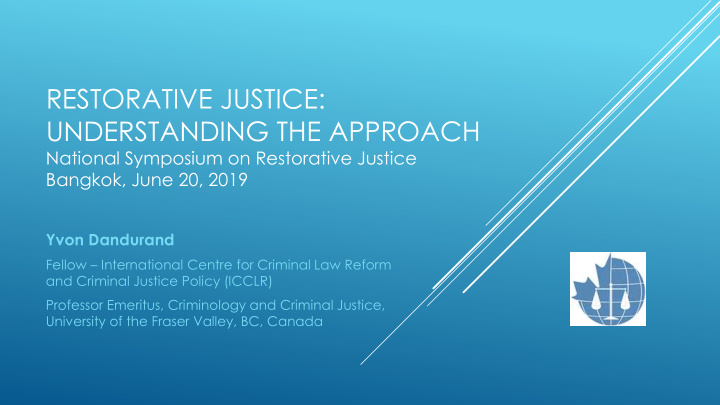



RESTORATIVE JUSTICE: UNDERSTANDING THE APPROACH National Symposium on Restorative Justice Bangkok, June 20, 2019 Yvon Dandurand Fellow – International Centre for Criminal Law Reform and Criminal Justice Policy (ICCLR) Professor Emeritus, Criminology and Criminal Justice, University of the Fraser Valley, BC, Canada
Restorative justice is based on the idea that parties to a conflict ought to participate actively in repairing the harm, alleviating the suffering that it caused, and taking steps to prevent the further occurrence of the harm.
Various forms of victim-offender mediation More participatory, community-based VARIATIONS IN approaches PROGRAMMES Focus on diversion and alternative to the justice system AND Focus on the reintegration of the offenders APPROACHES Focus on assistance to victims
A focus on the harm caused by crime Voluntary participation by those most affected by the harm, including the victim, the perpetrator and, in some processes, their COMMON supporters, members of the community, and appropriate professionals CHARACTERISTICS The process is prepared and facilitated by a trained restorative practitioner Dialogue between the parties to arrive at a OF RESTORATIVE mutual understanding of what happened and its consequences and an agreement JUSTICE on what should be done Outcomes of the restorative process vary and may include some reparative action for PROGRAMMES the victim or for the community An offer of support to the victim to aid recovery Support the reintegration of the offender and his or her desistance from crime
Support Support victims, give them a voice, enable their participation, and address their needs Restore Restore community order and peace and repair or heal damaged relationships Denounce Denounce criminal behaviour as unacceptable and reaffirm community values Encourage Encourage all concerned parties to take responsibility, especially the offender Identify Identify restorative, forward-looking outcomes Prevent recidivism by encouraging change in individual offenders and facilitate their Prevent reintegration into the community RESTORATIVE JUSTICE OBJECTIVES
wider access to justice more effective resolution of conflicts greater victim satisfaction a therapeutic impact on the victim greater likelihood of offenders' desistance from crime greater likelihood of successful social reintegration of offenders greater community engagement and confidence in the justice system. THE MANY BENEFITS OF RESTORATIVE JUSTICE PROGRAMMES
BASIC PRINCIPLES “Member States should ON THE US OF consider the formulation of national strategies and policies RESTORATIVE aimed at the development of JUSTICE restorative justice and at the promotion of a culture PROGRAMMES IN favourable to the use of CRIMINAL restorative justice among law enforcement, judicial and MATTERS (2002) social authorities, as well as local communities” (para 20).
Participation of an offender in a restorative justice process should not be used as evidence of admission of guilt in subsequent legal proceedings. Agreements arising out of a restorative process should be arrived at voluntarily and should contain only reasonable and proportionate obligations. The confidentiality of proceedings must be protected. Failure to reach an agreement should not be used against the offender in subsequent criminal justice proceedings. RECOMMENDED SAFEGUARDS
The right of the victim and the offender to consult with legal counsel concerning the restorative justice process. RIGHTS OF PARTICIPANTS The right of minors participating in a restorative justice process to the assistance of a parent or guardian. (OFFENDERS The right of parties to be fully informed about their rights, the AND VICTIMS) nature of the restorative justice process, and the possible consequences of their participation in the process. The right not to participate. The consent of both the victim and the offender is required. Neither the victim nor the offender should be coerced, or induced by unfair means, to participate in restorative processes or to accept restorative outcomes.
The conditions for the referral of cases THE BASIC to restorative justice programmes; PRINCIPLES The handling of cases following a restorative justice process; RECOMMEND The qualifications, training, and THE ADOPTION assessment of facilitators; OF NATIONAL The administration of restorative justice programmes; and, GUIDELINES TO Standards of competence and rules of COVER: conduct governing the operation of restorative justice programmes .
Declaration of Basic Principles of Justice for Victims of Crime and Abuse of Power (1989) United Nations Standard Minimum Rules for the Treatment of Prisoners (the Nelson Mandela Rules, 2015) United Nations Rules for the Treatment of Women Prisoners and Non- custodial Measures for Women Offenders (the Bangkok Rules, 2010) The Convention of the Rights of the Child (CRC)(1989) United Nations Model Strategies and Practical Measures on the Elimination of Violence against Children in the Field of Crime Prevention and Criminal Justice (2014) Council of Europe’s Recommendation (2018) 8 concerning restorative justice in criminal matters European Union’s Victims’ Rights Directive (2012) OTHER RELEVANT STANDARDS
USE OF RESTORATIVE JUSTICE Outside of the justice system At any stage within the criminal justice process, either instead of or in addition to criminal sanctions With most types of offences, including serious offences, provided that certain important precautions are taken (reservations are often expressed about the use of RJ in cases involving child victims or victims of violent offences)
Concerns for the victim’s safety WHY WE NEED The frequent power imbalance between the offender and the victim TO PROCEED The traumatic impact of the offence on the CAUTIOUSLY victim and the concern that the restorative justice process may compound the trauma WITH The fear of re-victimization PROGRAMMES The need to assess victims and ensure that they are psychologically ready to participate FOR SERIOUS in a restorative justice process The lack of victim assistance services for follow- VIOLENT CRIMES up support The need for special training for facilitators
Yvon.Dandurand@ufv.ca
Recommend
More recommend